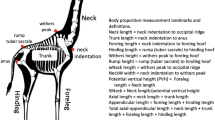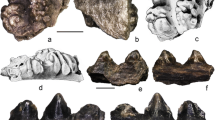Abstract
Non-geographic morphometric variation, particularly at the level of sexual dimorphism and ontogenetic (age-related) variation, has been documented in rodents, and useful for establishing whether to analyse sexes separately or together, and for selecting adult specimens for subsequent data recording and analysis. However, such studies have largely been based on traditional morphometric analyses of linear measurements that mainly focus on overall size, rather than shape-related morphometric variation. Unit-free, landmark/outline-based geometric morphometric analyses are considered to offer a more appropriate tool for assessing shape-related morphometric variation. In this study, we used geometric cranial morphometric analysis to assess the nature and extent of sexual dimorphism and age variation within the Tete veld rat, Aethomys ineptus (Thomas and Wroughton, 1908) from southern Africa and the African Nile rat, Arvicanthis niloticus (Desmarest, 1822) from Sudan. The results obtained were in turn compared with previously published results based on independent geometric and traditional cranial morphometric data from the same sampled populations examined in the present study. While our geometric morphometric results detected statistically significant sexual dimorphism in cranial shape within Ar. niloticus only, previously published results based on traditional morphometric data failed to detect significant sexual dimorphism within this species. However, similar to previously published traditional morphometric data, our geometric morphometric results detected statistically significant age-related variation in cranial shape and size within both Ae. ineptus and Ar. niloticus, with individuals of age classes 5 and 6 being considered to represent adult specimens. Our results highlight the importance of carefully evaluating both size- and shape-related non-geographic morphometric variation prior to the analysis of geographic variation and the delineation of species. Erroneous conclusions of non-geographic variation may have implications in the interpretation of geographic and evolutionary processes that may be responsible for morphological differences at both the inter- and intra-specific levels.
Similar content being viewed by others
References
Abdel-Rahman, E.H. 2005. Taxonomic status of Arvicanthis Lesson, 1842 from Sudan. Ph.D. Thesis, University of Kwa-Zulu Natal, Durban, South Africa.
Atchley, W.R., Cowley, D.E., Vogl, C., Mclellan, T. 1992. Evolutionary divergence, shape change and genetic correlation structure in the rodent mandible. Syst. Biol. 41, 196–221.
Bailey, R.C., Byrnes, J. 1990. A new, old method for assessing measurement error in both univariate and multivariate morphometric studies. Syst. Zool. 39, 124–130.
Bookstein, F.L. 1986. Size and shape spaces for landmark data in two dimensions. Stat. Sci. 1, 181–222.
Bronson, F.H. 1989. Mammalian Reproductive Biology. University of Chicago Press, Chicago and London.
Cesaroni, D., Matarazzo, P., Allegrucci, G., Sbordoni, V. 1997. Comparing patterns of geographic variation in cave crickets by combining geostatistic methods and Mantel tests. J. Biogeo 24, 419–431.
Chimimba, C.T., Dippenaar, N.J. 1994. Non-geographic variations in Aethomys chrysophilus (De Winton, 1897) and A. namaquensis (A. Smith, 1834) (Rodentia: Muridae) from Southern Africa. S. Afr. J. Zool. 29, 107–117.
Clutton-Brock, T.H., Iason, G.R., Guinness, F.E. 1987. Sexual segregation and density-related changes in habitat use in male and female red deer (Cervus elaphus). J. Zool. (London) 211, 275–289.
Darwin, C.R. 1859. The Origins of Species by Means of Natural Selection. Murray, London.
Darwin, C.R. 1874. The Descent of Man, and Selection in Relation to Sex, second ed. J. Murray, London.
Delany, M.J. 1975. The Rodents of Uganda. Trustees of the British Museum (Natural History), London.
Fadda, C., Corti, M. 1998. Geographic variation of Arvicanthis (Rodentia, Muridae) in the Nile Valley. Z. Säugetierkd. 63, 104–113.
Gould, S.J. 1966. Allometry and size in ontogeny and phylogeny. Biol. Rev. 41, 587–640.
Hingst-Zaher, E., Marcus, L.F., Cerqueira, R. 2000. Morpholoigcal integration during ontogeny in Calomys tener (Sigmodontinae: Rodentia). Hystrix 11, 99–113.
Hood, C.S. 2000. Geometric morphometric approaches to the sexual size dimorphism in mammals. Hystrix 11, 77–90.
Krzanowski, W.J. 1988. Principles of Multivariate Analysis. Oxford University Press, Oxford.
Lieberman, D.E., Krovitz, G.E., Yates, F.W., Devlin, M., St. Claire, M. 2004. Effects of food processing on masticatory strain and craniofacial growth in a retrognathic face. J. Hum. Evol. 46, 655–677.
Linzey, A.V., Kesner, M.H., Chimimba, C.T., Newbery, C. 2003. Distribution of veld rat sibling species Aethomys chrysophilus and Aethomys ineptus (Rodentia: Muridae) in southern Africa. Afr. Zool. 38, 169–174.
Marcus, L.F. 1990. Traditional morphometrics. In: Rohlf, F.J., Bookstein, F.L. (Eds.), Proceedings of the Michigan Morphometric Workshop. University Michigan Museums, Ann Arbor, pp. 77–122.
Mayr, E., Ashlock, P.D. 1991. Principles of Systematic Zoology, second ed. McGraw-Hill Inc., New York.
Monteiro, L.R., Lessa, L.G., Abe, A.S. 1999. Ontogenic variation in skull shape of Trichomys apereoides (Rodentia: Echimyidae). J. Mammal. 80, 102–111.
Monteiro, L.R., Duarte, L.C., Dos Reis, S.F. 2003. Environmental correlates of geographical variation in skull and mandible shape of the punare rat Trichomys apereoides. J. Zool. (London) 261, 47–57.
Morris, P. 1972. A review of mammalian age determination methods. Mammal Rev. 2, 69–104.
Musser, G.D., Carleton, M.D. 2005. Family Muridae. In: Wilson, D.E., Reeder, D.M. (Eds.), Mammals Species of the World. A Taxonomic and Geographic Reference. Smithsonian Institution Press, Washington, DC, pp. 501–755.
Olson, E.C., Miller, R.J. 1958. Morphological Integration. University of Chicago Press, Chicago.
Patton, J.L., Rogers, M.A. 1983. Systematic implications of non-geographic variation in the spiny rat genus Proechimys (Echimyidae). Z. Säugetierkd. 48, 363–370.
Piersma, T., Drent, J. 2003. Phenotypic flexibility and the evolution of organism design. Trends Ecol. Evol. 18, 228–233.
Polly, P.D. 2001. On morphological clocks and paleophylogeography: towards a timescale for Sorex hybrid zones. Genetica 112/113, 339–357.
Pucek, Z., Lowe, V.P. 1975. Age criteria in small mammals. In: Golley, F.B., Petrusewicz, K., Ryszkowski, L. (Eds.), Small Mammals: Their Productivity and Population Dynamics. Cambridge University Press, Cambridge, pp. 55–72 (Chapter 3).
Ricklefs, R.E., Finch, C.E. 1995. Patterns of aging. In: Aging: A Nature History. Scientific American Library, New York, pp. 1–17.
Rohlf, F.J. 1996. NTSYS-pc. Numerical Taxonomy and Multivariate Analysis System. Exeter, Setaukel, New York.
Rohlf, F.J. 2003. TpsSmall: Is Shape Variation Small. Department of Ecology and Evolution, State University of New York at Stony Brook, Stony Brook, New York.
Rohlf, F.J., 2004. TPS Series. Department of Ecology and Evolution, State University of New York, Stony Brook, New York.
Rohlf, F.J., Slice, D.E. 1990. Extensions of the Procrustes method for the optimal superimposition of landmarks. Syst. Zool. 39, 40–59.
Satoh, K., Iwaku, F. 2004. Internal architecture, origininsertion site, and mass of jaw muscles in Old World hamsters. J. Morphol. 260, 101–116.
Schoener, T.W. 1967. The ecological significance of sexual dimorphism in size in the lizard Anolis conspersus. Sci. Stanford 155, 474–477.
Schulte-Hostedde, A.I., Millar, J.S., Hickling, G.J. 2001. Sexual dimorphism in body composition of small mammals. Can. J. Zool. 79, 1016–1020.
Sneath, P.H., Sokal, R.R. 1973. Numerical Taxonomy. Freeman, San Francisco.
Sokal, R.R., Rohlf, F.J. 1981. Biometry. W.H Freeman, New York.
Taylor, P.J., Kumirai, A., Contrafatto, G. 2005. Species with fuzzy borders: the taxonomic status and species limits of saunders’vlei rat, Otomys saundersiae Roberts, 1929 (Rodentia: Muridae: Otomyini). Mammalia 69, 297–322.
Thorpe, R.S. 1976. Biometric analysis of geographic variation and racial affinities. Biol. Rev. 51, 407–452.
Weckerly, F.W. 1998. Sexual-size dimorphism: influence of mass and mating system in the most dimorphic mammals. J. Mammal. 79, 33–52.
Wickens, A.P. 1998. The Causes of Aging. Harwood Academic Publishers, Amsterdam.
Yamada, K., Kimmel, D.B. 1991. The effect of dietary consistency on bone mass and turnover in the growing rat mandible. Arch. Oral Biol. 36, 129–138.
Yu, H.-T., Lin, Y.-S. 1999. Age, reproduction, and demography of the spiny rat (Muridae: Niviventer coxingi)in subtropical Central Taiwan. Zool. Stud. 38, 153–163.
Zar, J.H. 1996. Biostatistical Analysis, fourth ed. Prentice-Hall Inc., Englewood Cliffs, NJ.
Zelditch, M.L., Carmichael, A.C. 1989. Ontogenetic variation in patterns of developmental and functional integration in skulls of Sigmodon fulviventer. Evolution 43, 814–824.
Zelditch, M.L., Bookstien, F.L., Lundrigan, B.L. 1992. Ontogeny of integrated skull growth in the cotton rat Sigmodon fulviventer. Evolution 46, 1164–1180.
Author information
Authors and Affiliations
Corresponding author
Rights and permissions
About this article
Cite this article
Abdel-Rahman, E.H., Taylor, P.J., Contrafatto, G. et al. Geometric craniometric analysis of sexual dimorphism and ontogenetic variation: A case study based on two geographically disparate species, Aethomys ineptus from southern Africa and Arvicanthis niloticus from Sudan (Rodentia: Muridae). Mamm Biol 74, 361–373 (2009). https://doi.org/10.1016/j.mambio.2008.06.002
Received:
Accepted:
Published:
Issue Date:
DOI: https://doi.org/10.1016/j.mambio.2008.06.002




